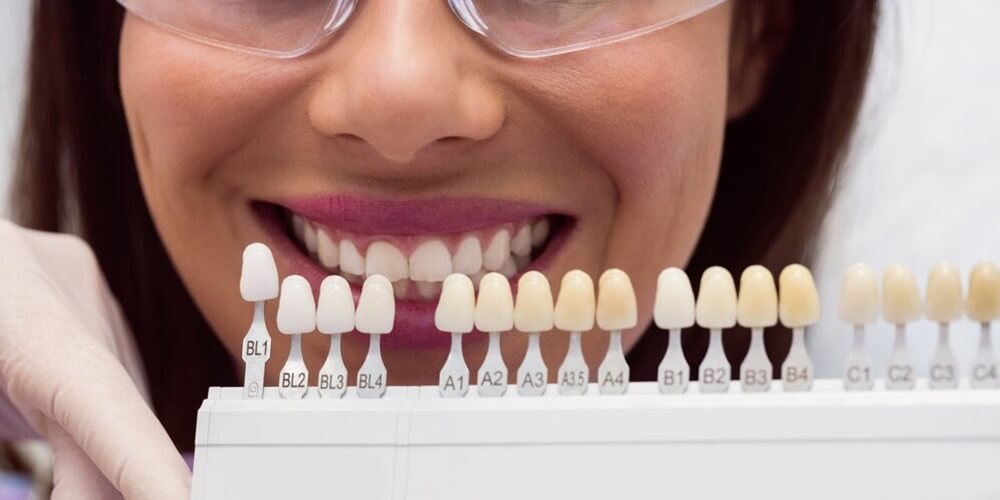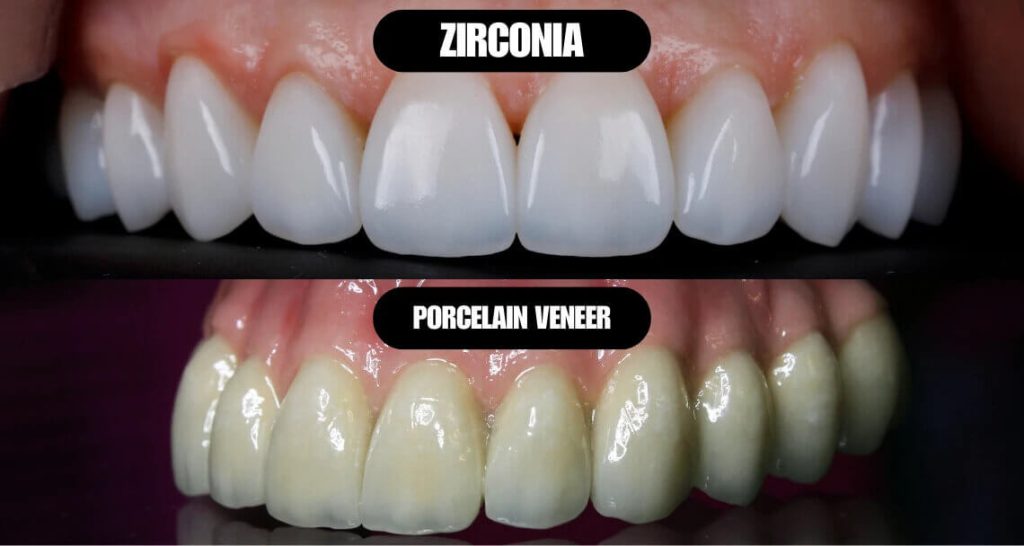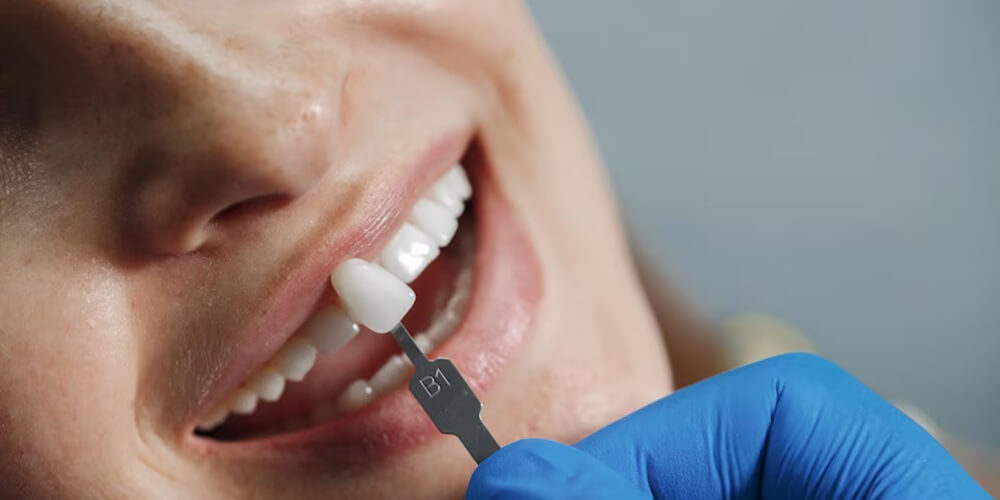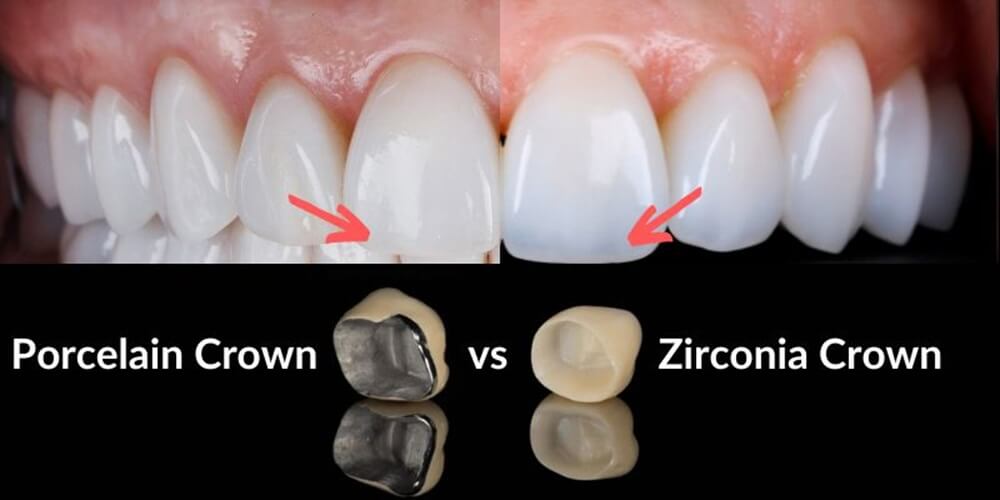Home » Zirconium Crowns vs. Porcelain Veneers: Which is Better for Dental Aesthetics?

The aesthetic value of the face has become increasingly important in recent years. Nowadays, in modern dentistry, the final aesthetically pleasing results in relation to the golden aesthetic proportion are the criteria sought in restoring teeth that have been missing for whatever cause. In addition, the replacement of removed teeth with new materials that have similar properties to the original teeth has had an impact on improving oral and dental health and aesthetics, which are an important aspect of general health. Dental crown types are used to protect heavily damaged or excessively restored teeth, obtain ball-shaped or aesthetic teeth, replace missing tooth tissue, and hold the fixed dental prostheses on the implants.
All-ceramic crowns, metal-supported porcelain crowns, and zirconium-supported crowns are among the new applications that have recently affected aesthetic dentistry. Veneers are minimally invasive computer-aided preparation, adhesive cementation, and aesthetic restorations that are applied to static or dynamic tooth surfaces in anterior interim restorations, correct tooth abnormalities such as form, diastema, shade, stain, and cracking, reduce multiple problems on the same tooth, are more resistant to stains than direct composite restorations, and provide better harmony with natural dentition. In this context, the advantages and disadvantages of adhesive porcelain veneer restorations applied to the teeth and restoring and maintaining oral health and dental aesthetics comparison with a non-adhesive CAD/CAM zirconium-based ceramic material were compared in this study. The comparative analysis of the zirconium crowns and porcelain veneers, currently frequently used, is the declared aim of this study. A comprehensive review of the literature on this subject has been conducted, and the two applications have been evaluated in terms of aesthetic success criteria established by various studies. In light of this information, the subject of treatment was evaluated based on the criteria of ceramics, preparation stage, clinical and laboratory phases, and surface characteristics. With the opportunity of technological developments, it is believed that prosthetic treatment will contribute to dental aesthetics comparison by providing an alternative. This paper will present both the direct and indirect restoration techniques of zirconium oxide core and the recent scientific aspects of zirconium in restorative dentistry.

Zircon ceramic is a representative of three-dimensional ceramics. It is outstanding for its biocompatibility, strength, and resistance. It is usually used in dental prosthetics. To achieve the aesthetic outcome in dentistry, full dental crown types can be used. Zirconium crowns are related to ceramics. In contrast, dental veneers are referred to as laminates, which are thin layers in dental terms. They have been repolished to give them luster on the outside, removing defects like discoloration and minor breakage. The veneers technique can be easily applied in all aesthetic or cosmetic dentistry operations. Among the many techniques existing today, the application of veneers on the front side of teeth can change the length, width, color, and size of a patient’s tooth in order to improve the smile. Dental veneers can be fabricated either from zircon construction or from conventional calcium silicate-based dental porcelain.The application of the porcelain veneers to enhance the patient’s smile has been extended because of the technology.
Over the years, giant steps in dental materials and laboratory procedures have married art and technology for excellent results. That is the most inspirational thing-transformation through porcelain veneer enhancement. Porcelain veneers are the ultimate solution for anyone who desires a lift in the aesthetic of their smile. This retrospective study describes a descriptive analysis of material structure and characteristics of zircon crowns and coatings, analyses previous assessments about dental aesthetics comparison, and discusses their functionality. The component analysis shows that the zircon crowns are made of a zirconium oxide substructure coated with dental porcelain, while materials such as metal, alumina, and glass ceramics are used to cover the coatings. With the different components used in zircon and solutions, a selection of different values of various properties is obtained, which affect the resulting aesthetics and functionality in the process of performing the basic and aesthetic analysis of the implants. The crown is used in dentistry to provide a comparison of the results of the two implant designs that are most often used in dentistry. The share of such manufacturing methods in Lithuania, in the context of the aesthetic properties of the final works and their assessment on the impact to be rendered on oral health and well-being of a patient, became the main impetus in the current study.
Complete knowledge of the “ideal aesthetic appearance” within the subjective world of the patient would also be a principal prerequisite for a proper diagnosis and good quality prosthodontic work. The introduction of techniques to conserve tooth structure and develop ceramic materials that mimic natural tooth structure has resulted in countless restorations that pass the vision test, even as seen through a high-powered microscope. Zirconium crowns and porcelain veneers are capable of producing soothing and natural restorations. Optical characteristics, including translucency and brightness of the porcelain veneer and zirconia, are the very critical aspects of a natural-looking zirconia crown and porcelain veneers. The addition of white zirconia cores with porcelain veneering causes a higher brightness, which must be somewhat corrected since natural teeth are less bright and they are relatively more red than blue-green.
Both zirconium dioxide and lithium disilicate ceramic systems mimic natural teeth under different lighting conditions. The patient’s satisfaction at the end of therapy, in large part, is tied to the acceptability of the dental aesthetics comparison. Ninety-six percent of patients consider a smile to be an important social asset, and 74% perceive that an unattractive smile can harm a person’s possibility for career success. The widespread use of acid-etch techniques to attach resin to enamel has favored a more conservative approach to the preparation for maxillary anterior veneers, but in some cases, placements with marginal tissue recession, reduced labiolingual dimensions, or facial dehiscences do not have the enamel support needed for a predictable short-term and long-term result. Aesthetic demands in some situations can greatly increase one’s preference between zirconia or porcelain restoration.

These parameters of durability and longevity are most important because the duration of survival of restorations is, throughout the history of dental literature, accepted as a mark of progress in dental materials. The long-term success of any restoration will depend on the performance of the materials used and their mechanical properties. Many researchers believe that the wear and fracture resistance properties affect the long-term success of these acrylics and ceramics. Conventional zirconia has an average tensile strength of up to 1200 MPa with a radial fracture toughness of up to 9 MPa. However, several clinical validation studies on the wear resistance properties of veneers have shown opposite results. Researchers have identified the marginal gap as one of the most important causes of the service life of veneers.
The oral hygiene of the patient also plays a role in the maintenance of veneers in the oral cavity. Inadequate or improper oral hygiene may increase the problems associated with esthetic veneers, such as rebound and tooth sensitivity over time. A total of 17 crowns and 130 veneers were evaluated. Dental crown types have a survival rate of 4.3% over 6 years. At 3 years, the overall survival rate for veneers was over 95%, with a failure rate of 4.8% after 6 years. Lastly, the strength of the veneer material and the core material were also observed. Perhaps the most important interest is whether the restoration will survive for at least five years. However, artificial aging has suggested that the core-veneer bond materials tested do not deteriorate over time. Longevity is of particular importance because veneers are one of the most costly fixed restoration options on the market for patients and dentists. It is generally believed that veneers are less conservative and cost-effective, providing all patients access to esthetic restoration. Identifying the likelihood of veneer survival may further inform patients and dentists about the overall selection process. This will become important as the demand for esthetic restoration continues to rise. The reduced service life of the restoration and the need for repair and replacement can be particularly problematic.

Zirconium crown cost is one of the major concerns that many people have for dental restorations, and it comes as no surprise that this dictates many informed patients’ decisions. The saying goes, however, “you get what you pay for,” which in large part also applies to dental restorations. Obviously, one hundred percent of the people would wish to pay the lowest price for the best possible quality of dental restoration, taking into account of course that the restorative material must be the strongest and most aesthetic possible. That isn’t always possible, but there is an optimal restorative option for patients, and it varies for each individual.
Porcelain veneer placement is less of an investment for a patient in materials and labor. Typically, porcelain veneers Turkey cost are half of a zirconium crown for a patient seeking a smile restoration or aesthetic work. While each patient has a different set of teeth and the zirconium crown cost for materials can vary, on average, porcelain veneer placement costs five hundred more than one maxillary zirconium anterior tooth only. For an immediate complete smile makeover or full mouth restoration, multiple additional costs are involved, yet the baseline zirconium crown cost on a per unit basis is approximately five hundred per unit for porcelain veneer placement. Financially, over time, a few visits to the dentist’s office can add up! Inexpensive restorations can also lead to future costs. Dental crown types and veneers of poor quality may develop microscopic openings at the margins as they degenerate, allowing harmful bacteria to move through the openings and attack teeth. Teeth with crowns may decay from under the crowns if oral hygiene is not strictly maintained. If a crown wears down, chips, or breaks and long-term warranties are not available, costs add up — this permanent restoration may have to be replaced promptly if it fails. The issues with repeat dental work include the occasional need to have bone grafts in areas where teeth may have been extracted two or more times by faulty dentistry.
Hello!